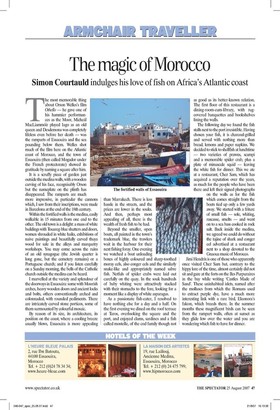The magic of orocco
Simon Courtauld indulges his love of fish on Africa's Atlantic coast -7 he most memorable thing about Orson Welles's film Othello — he gave one of his hammier performances as the Moor, Micheal MacLiamm6ir played Iago as an old queen and Desdemona was completely lifeless even before her death — was the ramparts of Essaouira and the sea pounding below them. Welles shot much of the film here on the Atlantic coast of Morocco, and the town of Essaouira (then called Mogador under the French protectorate) showed its gratitude by naming a square after him.
It is a scruffy piece of garden just outside the medina walls, with a wooden carving of his face, recognisably Orson but the nameplate on the plinth has disappeared. The ramparts are much more impressive, in particular the cannons which, I saw from their inscriptions, were made in Barcelona at the end of the 18th century.
Within the fortified walls is the medina, easily walkable in 15 minutes from one end to the other. The old town is a delight: a mass of white buildings with Touareg-blue shutters and doors, women shrouded in white haiks, exhibitions of naive paintings and beautifully carved thuya wood for sale in the alleys and marquetry workshops. You may come across the ruins of an old synagogue (the Jewish quarter is long gone, but the cemetery remains) or a Portuguese church; and if you listen carefully on a Sunday morning, the bells of the Catholic church outside the medina can be heard.
I marvelled at the variety and splendour of the doorways in Essaouira: some with Moorish arches, heavy wooden doors and ancient locks and bolts, others conventionally arched and colonnaded, with rounded pediments. There are intricately carved stone porticos, some of them surmounted by colourful mosaic.
By reason of its size, its architecture, its position on the coast, where a cooling breeze usually blows, Essaouira is more appealing than Marrakech. There is less hassle in the streets, and the prices are lower in the souks. And then, perhaps most appealing of all, there is the wealth of fresh fish to be had.
Beyond the smaller, open boats, all painted in the town's trademark blue, the trawlers wait in the harbour for their next fishing foray. One evening we watched a boat unloading boxes of highly coloured and sharp-toothed moray eels, also conger eels and the similarly snake-like and appropriately named sabre fish. Netfuls of spider crabs were laid out carefully on the quay. In the souk hundreds of baby whiting were attractively stacked with their stomachs to the fore, looking for a moment like a display of white asparagus.
As a passionate fish-eater, I resolved to have nothing else for a day and a half. On the first evening we dined on the roof terrace at Taros, overlooking the square and the port, and enjoyed clams, sardines and a fish called mostelle, of the cod family though not as good as its better-known relation. The first floor of this restaurant is a dining-room-cum-library, with rugcovered banquettes and bookshelves lining the walls.
The following day we found the fish stalls next to the port irresistible. Having chosen your fish, it is charcoal-grilled and served with nothing more than bread, lemons and paper napkins. We decided to stick to shellfish at lunchtime — two varieties of prawns, scampi and a memorable spider crab, plus a plate of minuscule squid — leaving the white fish for dinner. This we ate at a restaurant, Chez Sam, which has acquired a reputation over the years, as much for the people who have been there and left their signed photographs on the walls as for the fish which comes straight from the boats tied up only a few yards away. We started with a friture of small fish — sole, whiting, rascasse, smelts — and went on to a sea bass cooked in rock salt. Back inside the medina, we agreed we could do without the tajine of shark and conger eel advertised at a restaurant next to a shop devoted to the Gnaoua music of Morocco.
Jimi Hendrix is one of those who apparently once visited Chez Sam but, contrary to the hippy lore of the time, almost certainly did not sit and gaze at the forts on the Iles Purpuraires in the bay while writing 'Castles Made of Sand'. These uninhabited islets, named after the molluscs from which the Romans used to extract purple dye, have a much more interesting link with a rare bird, Eleonora's falcon, which breeds there. In the summer months these magnificent birds can be seen from the rampart walls, often at sunset as they glide low over the water and you are wondering which fish to have for dinner.









































 Previous page
Previous page